AUTOMATIC TRANSMISSION POWERTRAIN CONSTRUCTION/OPERATION
BHE051301026A06
Outline
• In the powertrain system, hydraulic pressure is transported from the control valves to operate the clutches and brakes and the planetary gear changes the gear ratio according to the vehicle driving condition.
• To improve shift quality, a plate-type clutch pack 2-4 brake, which has optimum control at low oil temperatures and is unaffected by changes over time, is used.
• A highly rigid transmission case has been adopted to reduce noise and vibration.
• The powertrain system of the RC4A-EL type consists of three pairs of clutches, two pairs of brakes, a one-way clutch, and two pairs of single type planetary gears.
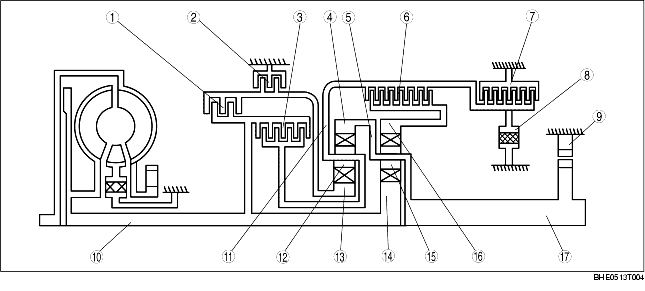
|
1
|
Reverse clutch
|
|
2
|
2-4 brake
|
|
3
|
High clutch
|
|
4
|
Front internal gear
|
|
5
|
Rear planetary carrier
|
|
6
|
Low clutch
|
|
7
|
Low and reverse brake
|
|
8
|
Low one-way clutch
|
|
9
|
Parking pawl
|
|
10
|
Input shaft
|
|
11
|
Front planetary carrier
|
|
12
|
Front pinion gear
|
|
13
|
Front sun gear
|
|
14
|
Rear sun gear
|
|
15
|
Rear pinion gear
|
|
16
|
Rear internal gear
|
|
17
|
Output shaft
|
Operation
-
Note
-
• All rotation directions are as viewed from the side cover.
Component description
|
Component
|
Function
|
|
Low clutch
|
• Transmits rotation of front planetary carrier to rear internal gear
• Operates in 1GR, 2GR, or 3GR position
|
|
High clutch
|
• Transmits rotation of input shaft to front planetary carrier
• Operates in 3GR or 4GR position
|
|
Reverse clutch
|
• Transmits rotation of reverse clutch drum to front sun gear
• Operates when vehicle is reversing
|
|
2-4 brake
|
• Prevents rotation of front sun gear
• Operates in 2GR or 4GR position
|
|
Low and reverse brake
|
• Prevents rotation of front planetary carrier
• Operates when vehicle is reversing or in 1GR position (M range)
|
|
Low one-way clutch
|
• Locks clockwise rotation of front planetary carrier in 1GR position
|
|
Planetary gear
|
• The planetary gear functions as a transmission due to the engagement/disengagement of clutches and/or brakes, converts the transmitted driving force of the input shaft and transmits it to the output shaft.
|
Powerflow
P position
-
• The driving force of the input shaft is transmitted to the rear sun gear and the reverse and high clutch drum. However, since none of the clutches are operating, the driving force is not transmitted to the output shaft. Accordingly, the vehicle is under conditions enabling movement but since the parking pawl mechanically locks the output shaft, the rear planetary gear and front internal gear are locked. Due to this, the vehicle is stopped.
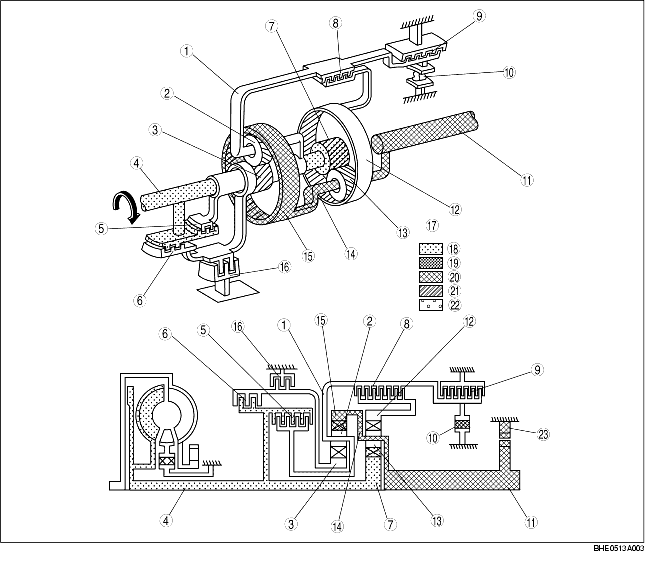
|
1
|
Front planetary carrier
|
|
2
|
Front pinion gear
|
|
3
|
Front sun gear
|
|
4
|
Input shaft
|
|
5
|
High clutch
|
|
6
|
Reverse clutch
|
|
7
|
Rear sun gear
|
|
8
|
Low clutch
|
|
9
|
Low and reverse brake
|
|
10
|
Low one-way clutch
|
|
11
|
Output shaft
|
|
12
|
Rear internal gear
|
|
13
|
Rear pinion gear
|
|
14
|
Rear planetary carrier
|
|
15
|
Front internal gear
|
|
16
|
2-4 brake
|
|
17
|
In relation to pinion:
|
|
18
|
Input
|
|
19
|
Output
|
|
20
|
Fixed
|
|
21
|
Pinion
|
|
22
|
Input (partial)
|
|
23
|
Parking pawl
|
R position
-
• Driving force from the input shaft is transmitted to the reverse and high clutch drum, then via the reverse clutch to the front sun gear, which rotates clockwise. At this point, the front pinion gear does not revolve because the front planetary carrier is locked by the low and reverse brake.
-
Due to this, the front sun gear causes the front pinion gear to rotate axially counterclockwise. This rotation causes the front internal gear and the rear planetary gear to rotate counterclockwise. As a result, the output shaft also rotates counterclockwise and this driving force is transmitted via the propeller shaft to the driving wheels.
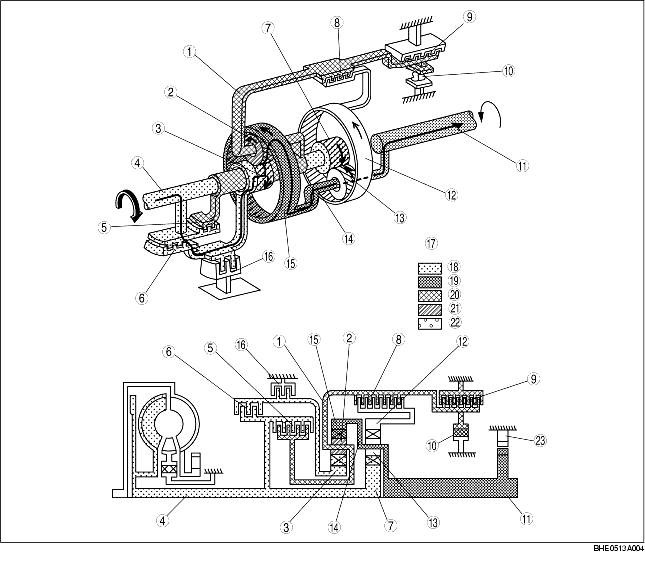
|
1
|
Front planetary carrier
|
|
2
|
Front pinion gear
|
|
3
|
Front sun gear
|
|
4
|
Input shaft
|
|
5
|
High clutch
|
|
6
|
Reverse clutch
|
|
7
|
Rear sun gear
|
|
8
|
Low clutch
|
|
9
|
Low and reverse brake
|
|
10
|
Low one-way clutch
|
|
11
|
Output shaft
|
|
12
|
Rear internal gear
|
|
13
|
Rear pinion gear
|
|
14
|
Rear planetary carrier
|
|
15
|
Front internal gear
|
|
16
|
2-4 brake
|
|
17
|
In relation to pinion:
|
|
18
|
Input
|
|
19
|
Output
|
|
20
|
Fixed
|
|
21
|
Pinion
|
|
22
|
Input (partial)
|
|
23
|
Parking pawl
|
N position
-
• Driving force from the input shaft is transmitted to the rear sun gear and the reverse and high clutch drum. However, since none of the clutches are operating, the driving force is not transmitted to the output shaft. Accordingly, the vehicle is under conditions enabling movement.
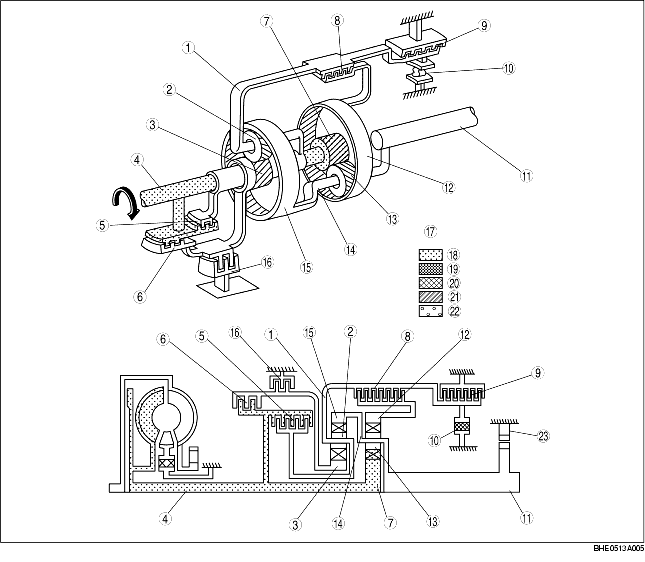
|
1
|
Front planetary carrier
|
|
2
|
Front pinion gear
|
|
3
|
Front sun gear
|
|
4
|
Input shaft
|
|
5
|
High clutch
|
|
6
|
Reverse clutch
|
|
7
|
Rear sun gear
|
|
8
|
Low clutch
|
|
9
|
Low and reverse brake
|
|
10
|
Low one-way clutch
|
|
11
|
Output shaft
|
|
12
|
Rear internal gear
|
|
13
|
Rear pinion gear
|
|
14
|
Rear planetary carrier
|
|
15
|
Front internal gear
|
|
16
|
2-4 brake
|
|
17
|
In relation to pinion:
|
|
18
|
Input
|
|
19
|
Output
|
|
20
|
Fixed
|
|
21
|
Pinion
|
|
22
|
Input (partial)
|
|
23
|
Parking pawl
|
D, S, L range 1GR (non-HOLD) (4AT), D range 1GR (Sport AT)
-
• Driving force from the input shaft is transmitted to the rear sun gear, which rotates clockwise, causing the rear pinion gear to rotate counterclockwise. At this point, since the rear planetary carrier is united with the output shaft (and therefore, the driving wheels), the load of the stopped vehicle fixes the rear planetary carrier and it does not revolve. Due to this, the counterclockwise rotation of the rear pinion gear causes the rear internal gear to also try to rotate counterclockwise but it is locked by the low one-way clutch via the low clutch. As a result, the rear pinion gear rotates axially counterclockwise, overcoming the load of the stopped vehicle and the rear planetary carrier revolves clockwise. Accordingly the output shaft also rotates clockwise and this driving force is transmitted via the propeller shaft to the driving wheels.
-
• During deceleration, the rear internal gear tries to rotate clockwise due to the rotation of the rear planetary carrier (rear pinion gear) being comparatively higher to that of the rear sun gear. At this point, since the low one-way clutch is not utilized and rotates freely, the rear internal gear rotates clockwise. In this way, engine braking is not actuated since the reverse torque from the driving wheels is not transmitted back towards the engine.
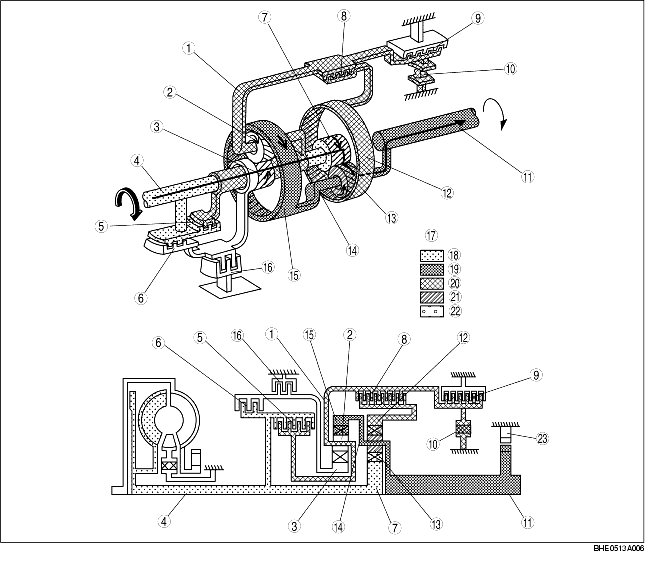
|
1
|
Front planetary carrier
|
|
2
|
Front pinion gear
|
|
3
|
Front sun gear
|
|
4
|
Input shaft
|
|
5
|
High clutch
|
|
6
|
Reverse clutch
|
|
7
|
Rear sun gear
|
|
8
|
Low clutch
|
|
9
|
Low and reverse brake
|
|
10
|
Low one-way clutch
|
|
11
|
Output shaft
|
|
12
|
Rear internal gear
|
|
13
|
Rear pinion gear
|
|
14
|
Rear planetary carrier
|
|
15
|
Front internal gear
|
|
16
|
2-4 brake
|
|
17
|
In relation to pinion:
|
|
18
|
Input
|
|
19
|
Output
|
|
20
|
Fixed
|
|
21
|
Pinion
|
|
22
|
Input (partial)
|
|
23
|
Parking pawl
|
L range 1GR (HOLD) (4AT), M range 1GR (Sport AT)
-
• The driving force from the input shaft is transmitted to the rear sun gear, which rotates clockwise causing the rear pinion gear to rotate counterclockwise. The rear internal gear does not rotate since it is locked by the low and reverse brake via the low clutch. As a result, the rear pinion gear rotates axially counterclockwise, overcoming the load of the stopped vehicle, causing the rear planetary carrier to revolve clockwise. Accordingly, the output shaft rotates clockwise and this driving force is transmitted via the propeller shaft to the driving wheels.
-
• During deceleration, the driving force is transmitted from the driving wheels. Due to this, the driving force becomes the reverse of that during acceleration and engine braking is actuated.
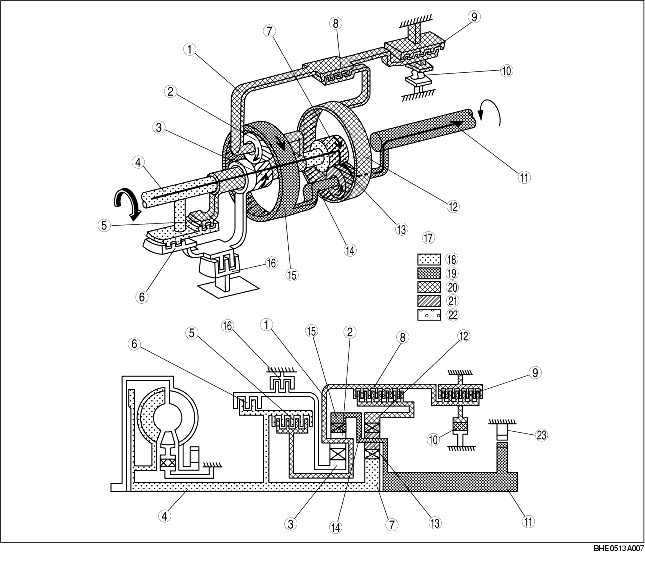
|
1
|
Front planetary carrier
|
|
2
|
Front pinion gear
|
|
3
|
Front sun gear
|
|
4
|
Input shaft
|
|
5
|
High clutch
|
|
6
|
Reverse clutch
|
|
7
|
Rear sun gear
|
|
8
|
Low clutch
|
|
9
|
Low and reverse brake
|
|
10
|
Low one-way clutch
|
|
11
|
Output shaft
|
|
12
|
Rear internal gear
|
|
13
|
Rear pinion gear
|
|
14
|
Rear planetary carrier
|
|
15
|
Front internal gear
|
|
16
|
2-4 brake
|
|
17
|
In relation to pinion:
|
|
18
|
Input
|
|
19
|
Output
|
|
20
|
Fixed
|
|
21
|
Pinion
|
|
22
|
Input (partial)
|
|
23
|
Parking pawl
|
D, S, L range 2GR (4AT), D, M range 2GR (Sport AT)
-
• The driving force from the input shaft is transmitted to the rear sun gear, which rotates clockwise causing the rear pinion gear to rotate counterclockwise. Then, the driving force causes the rear planetary carrier to rotate clockwise, similar to first gear. The front internal gear also rotates clockwise since it is united with the rear planetary gear. At this point, the front sun gear does not rotate because it is locked by the 2-4 brake. Due to this, the front pinion gear rotates axially clockwise and revolves clockwise, and the front planetary carrier rotates clockwise. The clockwise rotation of the front planetary carrier is transmitted via the low clutch to the rear internal gear, causing it to rotate clockwise.
-
As a result, the rotation speed of the rear planetary carrier increases from that of first gear in proportion to the rotation of the rear internal gear. Accordingly, the driving force from the rear planetary carrier, whose speed has been increased, is transmitted via the propeller shaft to the driving wheels.
-
• During deceleration, the driving force is transmitted from the driving wheels. Due to this, the driving force becomes the reverse of that during acceleration and engine braking is actuated.
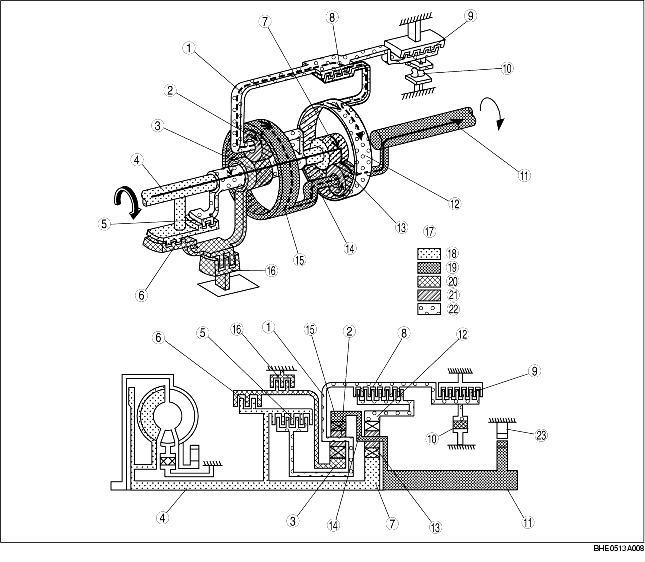
|
1
|
Front planetary carrier
|
|
2
|
Front pinion gear
|
|
3
|
Front sun gear
|
|
4
|
Input shaft
|
|
5
|
High clutch
|
|
6
|
Reverse clutch
|
|
7
|
Rear sun gear
|
|
8
|
Low clutch
|
|
9
|
Low and reverse brake
|
|
10
|
Low one-way clutch
|
|
11
|
Output shaft
|
|
12
|
Rear internal gear
|
|
13
|
Rear pinion gear
|
|
14
|
Rear planetary carrier
|
|
15
|
Front internal gear
|
|
16
|
2-4 brake
|
|
17
|
In relation to pinion:
|
|
18
|
Input
|
|
19
|
Output
|
|
20
|
Fixed
|
|
21
|
Pinion
|
|
22
|
Input (partial)
|
|
23
|
Parking pawl
|
D, S range 3GR (4AT), D, M range 3GR (Sport AT)
-
• The driving force from the input shaft is transmitted to the reverse and high clutch drum and then via the high clutch to the front planetary carrier, causing it to rotate clockwise. This clockwise rotation of the front planetary carrier is transmitted via the low clutch to the rear internal gear causing it to rotate clockwise. The driving force of the input shaft is transmitted to the rear sun gear and causing to rotate clockwise.
-
At this point, since the rear sun gear and rear internal gear are rotating clockwise at the same speed, the rear pinion gear does not rotate axially, and the rear sun gear and rear internal gear become united and revolve. The force of this revolution is transmitted to the rear planetary carrier, the output shaft and then, via the propeller shaft to the driving wheels.
-
• During deceleration, the driving force is transmitted from the driving wheels. Due to this, the driving force becomes the reverse of that during acceleration and engine braking is actuated.
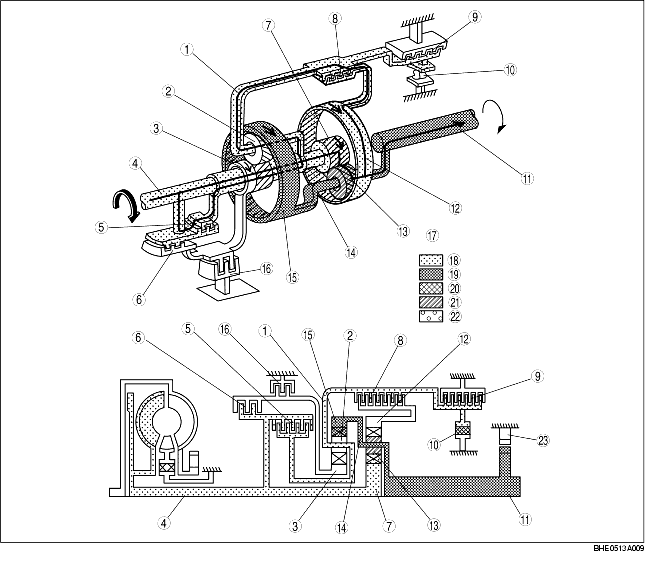
|
1
|
Front planetary carrier
|
|
2
|
Front pinion gear
|
|
3
|
Front sun gear
|
|
4
|
Input shaft
|
|
5
|
High clutch
|
|
6
|
Reverse clutch
|
|
7
|
Rear sun gear
|
|
8
|
Low clutch
|
|
9
|
Low and reverse brake
|
|
10
|
Low one-way clutch
|
|
11
|
Output shaft
|
|
12
|
Rear internal gear
|
|
13
|
Rear pinion gear
|
|
14
|
Rear planetary carrier
|
|
15
|
Front internal gear
|
|
16
|
2-4 brake
|
|
17
|
In relation to pinion:
|
|
18
|
Input
|
|
19
|
Output
|
|
20
|
Fixed
|
|
21
|
Pinion
|
|
22
|
Input (partial)
|
|
23
|
Parking pawl
|
D range 4GR (4AT), D, M range 4GR (Sport AT)
-
• The driving force from the input shaft is transmitted to the reverse and high clutch drum and then via the high clutch to the front planetary carrier, causing it to rotate clockwise. At this point, the front sun gear does not rotate because it is locked by the 2-4 brake. Due to this the front pinion gear revolves clockwise and rotates axially clockwise. This rotation causes the front internal gear rotation to increase speed and the rear planetary carrier to rotate clockwise. Accordingly, the driving force from the sped-up rear planetary carrier is transmitted, via the propeller shaft, to the driving wheels.
-
• During deceleration, the driving force is transmitted from the driving wheels. Due to this, the driving force becomes the reverse of that during acceleration and engine braking is actuated.
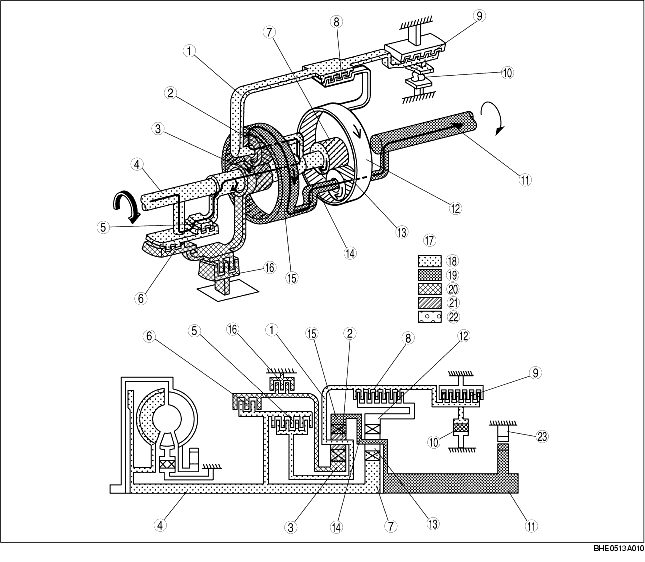
|
1
|
Front planetary carrier
|
|
2
|
Front pinion gear
|
|
3
|
Front sun gear
|
|
4
|
Input shaft
|
|
5
|
High clutch
|
|
6
|
Reverse clutch
|
|
7
|
Rear sun gear
|
|
8
|
Low clutch
|
|
9
|
Low and reverse brake
|
|
10
|
Low one-way clutch
|
|
11
|
Output shaft
|
|
12
|
Rear internal gear
|
|
13
|
Rear pinion gear
|
|
14
|
Rear planetary carrier
|
|
15
|
Front internal gear
|
|
16
|
2-4 brake
|
|
17
|
In relation to pinion:
|
|
18
|
Input
|
|
19
|
Output
|
|
20
|
Fixed
|
|
21
|
Pinion
|
|
22
|
Input (partial)
|
|
23
|
Parking pawl
|









